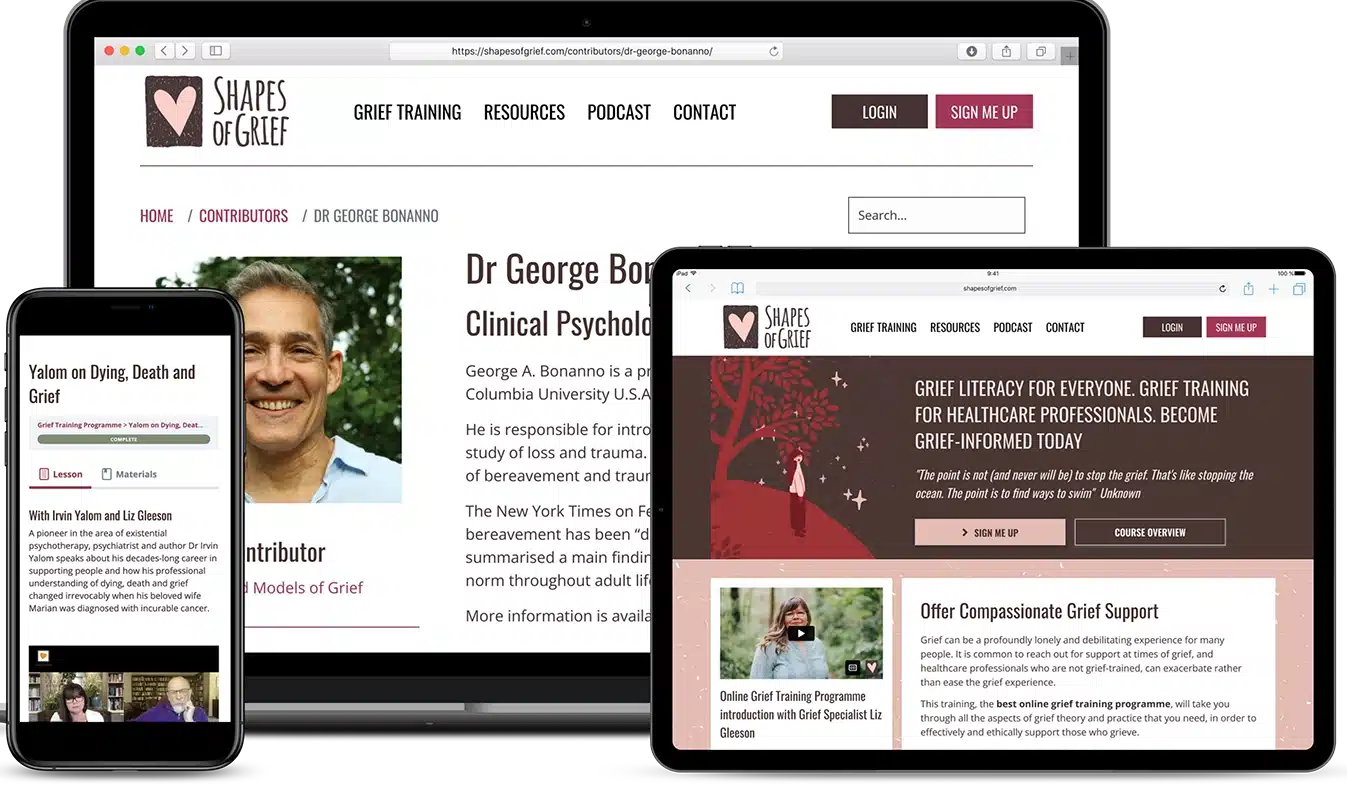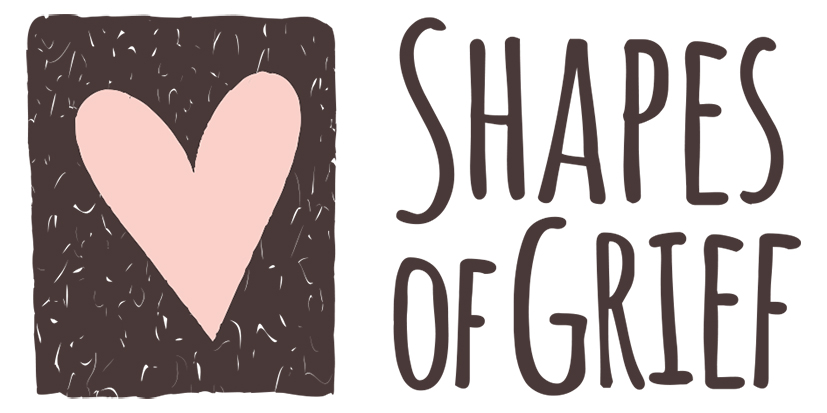Can we ever truly know the depth and breadth of the grief experience?
The tragic gap between the life we want and the life we have is a place often frequented by the grieving heart. The emotional pain experienced when a loved one dies can be so unbearable that it can seem easier to the bereaved to remain suspended in a non-acceptance of the death, replaying ‘if onlys’ and ‘what ifs’ for months and years: a psychic defence against the permanence of death. For when someone we love dies, so too does life as we know it. When it’s sudden or shocking, or a profound loss, people describe it like a fragmentation of self, a stripping of identity, losing the ground beneath them, feeling like they’re going crazy, drowning at sea while the rest of the world has the audacity to carry on as normal. And the loneliness of it, the isolation, the feeling of having been forgotten by a world that now feels unfamiliar, unsafe and often unkind. Our comfort zone shrinks, our social circle vanishes and our world becomes shrunken for a time: seen only through the myopic lens of loss.
There is so much more talk of grief in the media today, generated largely by the global pandemic and its death toll. We have seen footage of mass graves in New York, public cremations in India and bodies of loved ones left at the side of the road in Ecuador, when there was no more room in the morgues. For us, in our death-denying Western society, these images have been shocking, they have provoked death anxiety for many and forced us to confront the reality of our own mortality. Have we not all imagined, even just for a few moments, what it might be like to die from Covid-19? Or to die alone in hospital? What might such a death be like?
Many people haven’t had to imagine it, they have witnessed it. Some dressed head to toe in PPE gear, others from outside a hospital window, still others on the other side of a mobile phone or tablet. It has been a cruel experience to lose a loved one during this past year, from Covid-19 or other causes. Some have had to endure the inhumanity of being prevented from holding the hand of their loved one and saying such words as ‘I love you, thank you, safe journey, we’ll be okay, you can go now’ (rarely, do we actually say ‘goodbye’).
Grief is a poorly understood process for those who have not had first-hand experience. For those who are lucky enough not to have endured a significant loss in their lives, they can be forgiven for thinking that grief is something sad that happens when someone we love dies. We might feel low for a while until we eventually ‘get over it’ or ‘move on’: this couldn’t be farther than the truth. For many of us, grief changes us profoundly. It shakes up our normal, brings up a depth and breadth of emotions that can leave us shook or terrified: our mind can feel like there are three hundred TV channels playing all at once, loudest at three o’clock in the morning. I use the image of taking a sledge hammer to our nervous system and hitting it hard: it can take months before the reverberations of that begin to settle, leaving us in a state of hyper-vigilance, fear or anger. These difficult emotions often overshadow the expected sorrow and sadness which can confuse those who are trying to support us and make them withdraw, leading to even greater isolation for the griever.
Grief affects us physically too. Some studies show that we are more prone to heart attack, stroke, ulcerative colitis, rheumatoid arthritis and other conditions following a significant loss. Remember Carrie Fisher, the actress who played Princess Leia in Star Wars? She died in December 2016. Her heartbroken mother, actress Debbie Reynolds, died the next day from a stroke. We hear these stories time and again: broken-heart syndrome is a thing, not a myth. In my grief therapy practice, when I meet a newly bereaved person, it is often like meeting a very young child in pain; there is a vulnerability and a rawness, as if their very skin has been ripped off them and there is a desperation to feel ‘normal’ again. We must speak with the tenderness and care that we would afford a child who has become distressed after momentarily losing their parent: a profound humanity is required when accompanying those who are grieving.
Lobsters, apparently, when they grow too big for their shell, have to shed it and go into hiding until a new, bigger shell has grown back. I often think of lobsters when I am working with the bereaved.
Sigmund Freud was the first person who studied and wrote about grief. In his seminal paper, “Mourning and Melancholia” (Freud, 1917), he wrote about decathexis; the need to emotionally detach from our deceased loved one, after a period of mourning, so that we could re-attach to another love object. When his beloved daughter died some time later, everything that he had thought about grief changed. He realised that he would always carry Sophie in his heart and would never ‘get over’ her, nor would he want to. But a word of caution: many of us hold onto grief as if it’s the only place we find connection with our deceased loved ones. Love and grief are inextricably bound. When we begin to adapt to our loss, the love rather than the grief, gains volume again.
The truth is, we don’t get over a profound loss nor do we move on. Instead, we must learn to grow around our grief (Tonkin, 1996) so that it is more bearable to carry, learn to adjust to it, accommodate it in our lives, move forward with it. As children’s author Michael Rosen says in his book We’re Going on a Bear Hunt (Rosen, 1989) “you can’t go over it, you can’t go under it, you can’t go around it, you’ve got to go through it”: the only way to deal with grief is to grieve. And paradoxically, when we turn towards our pain and allow ourselves to fully surrender to it, only then, can we begin to feel relief from it.
I’ve heard talk about tsunamis of grief, or an epidemic of grief to come, but what does the research tell us about how we cope with grief? And what might grief in a post-pandemic society look like?
Clinical psychologist Dr George Bonanno in Colombia University has spent decades conducting research into why we grieve and how we grieve. He is responsible for some of the most robust research to date. The reality is, there is a whole spectrum of grief responses and individually, people can experience different losses in very different ways. Bonanno’s research tells us that for most people, about 60%, they don’t need professional grief support or counselling (Bonanno, 2004). Most people do need, however, support from family, friends and community, acknowledgement of their grief and information about how their grief may present, for example; low mood, insomnia, elevated anxiety, etc. Research tells us that about 40% of people will need more than the community supports available (Bonanno, 2004); they may benefit, for example, from a voluntary community group to meet other people who have experienced similar losses, such as Rainbows Ireland (for children), Anam Cara (for bereaved parents), HUGG or Pieta House (for people bereaved by suicide). The data shows that a small percentage of people (approximately 10%), will suffer from a condition known as Prolonged Grief Disorder, where our grief remains acute, the yearning for our deceased loved one can be unbearable and we don’t accommodate our grief over time (Shear & Mulhare, 2008). But, given that so little is known about Prolonged Grief Disorder, some people are wrongly diagnosed with depression or anxiety and thus miss out on proper diagnosis and effective treatment.
When we speak about loss, we must remember that there isn’t always a hearse. There are losses that can cause a profound grief response but are barely acknowledged by society; we call this disenfranchised grief. They can include miscarriage, separation or divorce, retirement, emigration, failed IVF or the end of a friendship. And just as there are many types of losses, there are many types of grief too. Anticipatory grief is the grief we may begin to experience the moment a loved one receives a difficult diagnosis. This can last for weeks, months, years and, for some, even decades. When we receive a difficult diagnosis, life can change irrevocably. Our assumptions about the future may be shattered and our sense of safety in the world can be lost, either temporarily or permanently. Ambiguous loss, a term coined by Dr Pauline Boss (Boss, 2009), is what we experience when our loved one is gone, presumed dead, but maybe not. Or when our loved one has dementia: physically present, psychologically absent, or following a brain injury: everything about our loved one has changed but they are not dead, yet we may silently grieve the person they were before the injury. There are many, many other ways that we experience loss and many other types of grief.
Not everyone needs professional support in their grief, as the research shows. In fact, some studies show that it can be detrimental if people seek support too early in a bereavement. Suggesting to someone that they seek counselling may leave them feeling like they mustn’t be coping properly or have them question their own natural resilience. We are hard-wired to heal, if we can just get out of our own way. Sometimes, when friends know that their grieving person is seeing a counsellor, they can withdraw some of the much-needed community based care. For those who themselves feel they may benefit from grief counselling, it is essential that they find a mental health provider who is grief-educated.
One of the biggest problems that those who are looking for support for their grief following the pandemic may face, is the lack of grief education among our healthcare providers and mental health workers. Many institutions are still teaching the outdated ‘Stages Model’ of grief (Kübler-Ross, 1973) which was never meant to be for grief in the first place. Elizabeth Kubler-Ross worked in palliative care and noticed, when told they had a terminal diagnosis, many patients went through these five stages. Using the stages model for grief is now considered to be outdated, inaccurate and potentially harmful (Stroebe et al, 2017), yet this theory still retains a position in popular culture. Grief is far more complex and multi-faceted. It does not have a beginning, a middle and an end, it is not linear and it simply cannot be reduced to a five-stage model. We need to think differently about grief and broaden our awareness of it if we are to adequately support those who are grieving and ensure that we provide them with the best possible chance for a good bereavement outcome. We’ve come a long way in our understanding of loss and grief since Freud first wrote about it in 1917, but we’ve still a long way to go. How we interact with those who are grieving can either ease or exacerbate their experience. For professionals, we need to become grief educated and grief informed. All of us need to drop the awful platitudes of ‘stay strong’, ‘you’ve an angel in heaven now’, ‘at least you had him for thirty years’ and instead ask about the loss, say their name, bear their grief without trying to fix, advise or change it. Not only do we need to allow the sobs, the snots and the tears, we need to welcome them. And equally, when someone is able to manage their loss well, get on with work and the business of living, we mustn’t second guess them or assume that they are avoiding grief. Remember, grief is a normal, adaptive response to loss and there is a whole spectrum of grief responses. How we each respond to a certain loss depends on a myriad of factors, there isn’t a single correct way to grieve.
In a supportive role, we mostly need to just show up and listen. Show-up and shut-up! If you’re not good at listening because grief is difficult for you, then make a dinner, cut the grass, do something practical. Research tells us that those who are recently bereaved often find the practical help to be more beneficial than emotional support. And if in doubt, just show kindness, it can really make a difference.
Liz Gleeson is a psychotherapist in private practice in Co. Wicklow. She is curator of the Shapes Of Grief Podcast and presents internationally on grief-related themes. She has an MA in Dramatherapy, MSc Bereavement Studies, MA Counselling & Psychotherapy and is currently a Phd Student. Liz is creator of the award-winning Shapes Of Grief online Grief Education Programme for mental health professionals, a global online project, and she teaches on the MSc Bereavement Studies at RCSI/Irish Hospice Foundation. Sign-up to the programme at www.shapesofgrief.com.
References
Bonanno, G. A. (2004). Loss, trauma, and human resilience: have we underestimated the human capacity to thrive after extremely aversive events?. American psychologist, 59(1), 20.
Kübler-Ross, E. (1973). On death and dying. Routledge.
Pauline, B., & Boss, P. (2009). Ambiguous loss: Learning to live with unresolved grief. Harvard University Press.
Freud S. (1917). Mourning and Melancholia. The Standard Edition of the Complete Psychological Works of Sigmund Freud, Volume XIV (1914-1916): On the History of the Psycho-Analytic Movement, Papers on Metapsychology and Other Works, p. 237-58.
Rosen, M., & Oxenbury, H. (1989). We’re going on a bear hunt.
Shear, M. K., & Mulhare, E. (2008). Complicated grief. Psychiatric annals, 38(10).
Stroebe, M., Schut, H., & Boerner, K. (2017). Cautioning health-care professionals: Bereaved persons are misguided through the stages of grief. OMEGA-Journal of death and dying, 74(4), 455-473.
Tonkin, L. (1996). Growing around grief—another way of looking at grief and recovery. Bereavement Care, 15(1), 10-10.
by Liz Gleeson, Published First in IAHIP journal ‘Inside Out’, Autumn 2021
Become grief-literate today!
Shapes of Grief Training Programme
Don't know what to do or say when someone is grieving? Afraid you'll make it worse? Become Grief-Trained today & learn how to deliver effective grief support.

Keep in the loop!
Subscribe for updates on grief related resources - we promise never to spam
Newsletter Signup Form
"*" indicates required fields


